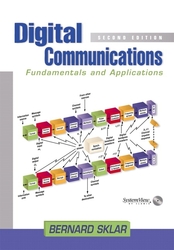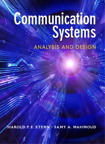Digital Transmission Systems, 3/e
暫譯: 數位傳輸系統(第三版)
David R. Smith
- 出版商: KAP
- 出版日期: 2003-11-30
- 售價: $1,350
- 貴賓價: 9.8 折 $1,323
- 語言: 英文
- 頁數: 808
- 裝訂: Hardcover
- ISBN: 1402075871
- ISBN-13: 9781402075872
-
相關分類:
Computer-networks
下單後立即進貨 (約5~7天)
買這商品的人也買了...
-
 精通 Vi (Learning the Vi Editor, 6/e)
精通 Vi (Learning the Vi Editor, 6/e)$550$435 -
 精通 Visual Basic.NET 中文版黑皮書 (Visual Basic.NET Black Book)
精通 Visual Basic.NET 中文版黑皮書 (Visual Basic.NET Black Book)$750$585 -
 Microsoft Windows Server 2003 系統實務
Microsoft Windows Server 2003 系統實務$780$663 -
 鳥哥的 Linux 私房菜-伺服器架設篇
鳥哥的 Linux 私房菜-伺服器架設篇$750$638 -
 鳥哥的 Linux 私房菜─基礎學習篇增訂版
鳥哥的 Linux 私房菜─基礎學習篇增訂版$560$476 -
 Project 2003 徹底研究
Project 2003 徹底研究$690$538 -
 Windows CE.NET 程式設計 (Programming Microsoft Windows CE .Net, 3/e)
Windows CE.NET 程式設計 (Programming Microsoft Windows CE .Net, 3/e)$890$703 -
 $1,782Linux Device Drivers, 3/e (Paperback)
$1,782Linux Device Drivers, 3/e (Paperback) -
 Linux iptables 技術實務─防火牆、頻寬管理、連線管制
Linux iptables 技術實務─防火牆、頻寬管理、連線管制$620$527 -
 Oracle Database 10g DBA 技術手冊 (Oracle Database 10g DBA Handbook)
Oracle Database 10g DBA 技術手冊 (Oracle Database 10g DBA Handbook)$990$842 -
 最新詳解 Javascript & HTML & CSS 語法辭典(增訂新版)
最新詳解 Javascript & HTML & CSS 語法辭典(增訂新版)$490$382 -
 深入淺出 Java 程式設計, 2/e (Head First Java, 2/e)
深入淺出 Java 程式設計, 2/e (Head First Java, 2/e)$880$695 -
 程式保護與破解 SoftICE 使用實例
程式保護與破解 SoftICE 使用實例$600$540 -
 Linux Mail Server 技術實務─架設、稽核、防毒、防垃圾信
Linux Mail Server 技術實務─架設、稽核、防毒、防垃圾信$580$493 -
 軟體預先架構之美學 (Prefactoring)
軟體預先架構之美學 (Prefactoring)$580$458 -
 深入淺出 Hibernate
深入淺出 Hibernate$650$507 -
 SQL Server 2005 資料庫開發聖經
SQL Server 2005 資料庫開發聖經$890$757 -
 駭客與畫家-電腦世紀的大觀念 (Hackers and Painters: Big Ideas from the Computer Age)
駭客與畫家-電腦世紀的大觀念 (Hackers and Painters: Big Ideas from the Computer Age)$300$237 -
 ASP.NET 2.0 網頁製作徹底研究, 2/e
ASP.NET 2.0 網頁製作徹底研究, 2/e$660$561 -
 Microsoft SQL Server 2005 設計實務
Microsoft SQL Server 2005 設計實務$680$578 -
 Visual Basic 2005 程式開發與介面設計秘訣
Visual Basic 2005 程式開發與介面設計秘訣$720$569 -
 配色王-最能激發創意與觸動人心的配色技法
配色王-最能激發創意與觸動人心的配色技法$360$281 -
 ASP.NET 2.0 程式設計
ASP.NET 2.0 程式設計$650$553 -
 專案管理之美學 (The Art of Project Management)
專案管理之美學 (The Art of Project Management)$620$490 -
 Ajax 網頁程式設計─Google 成功背後的技術
Ajax 網頁程式設計─Google 成功背後的技術$580$493
商品描述
Description:
Digital Transmission Systems, Third Edition, is a comprehensive overview of the theory and practices of digital transmission systems used in digital communication. This new edition has been completely updated to include the latest technologies and newest techniques in the transmission of digitized information as well as coverage of digital transmission design, implementation and testing.
Highlights of this edition:-New material on error correction codes, multiple access, digital modulation, digital subscriber lines, cable modems, mobile wireless, wide area networks, and optical networks;
-Up-to-date industry standards and practices - including voice/video coding, digital subscriber lines, SONET/SDH, DWDM, ATM, broadband wireless access, network synchronization, and network management - are described and interpreted;
-Expanded problem sets (totaling over 300) at the end of each chapter for review and practice;
-All chapters have been updated with particular emphasis given to fiber optics, wireless and networks.The book is heavily illustrated with tables, figures and an abundance of examples and references to actual systems. Examples are from common carriers, manufacturers and the author's commercial experience. Telecommunications terms are defined and explained when first introduced.
Practicing engineers in the field of communication systems, managers and technical personnel in the IT industry, and students of electrical and communications engineering will find this an authoritative state-of-the-art resource.
Table of Contents:
Preface. Acknowledgement.
1: Introduction to Digital Transmission Systems. 1.1. Historical Background. 1.2. Present-Day Digital Transmission. 1.3. Digital Transmission Standards. 1.4. Advantages of Digital Transmission. 1.5. A Simplified Digital Transmission System. 1.6. Summary.
2: Principles of System Design. 2.1. General Plan. 2.2. Transmission Services. 2.3. Hypothetical Reference Circuits. 2.4. Performance Objectives. 2.5. Summary. Problems. 3: Analog-to-Digital Conversion Techniques. 3.1. Introduction. 3.2. Pulse Code Modulation. 3.3. Differential PCM and Delta Modulation. 3.4. Adaptive Differential Pulse Code Modulation. 3.5. Subband Coding. 3.6. Transform Coding. 3.7. Comparison of Waveform Coders. 3.8. Voice Coders (Vocoders). 3.9. Hybrid Coders. 3.10. Video Coders. 3.11. Summary. Problems.
4: Time-Division Multiplexing. 4.1. Introduction. 4.2. Synchronous Multiplexing. 4.3. Asynchronous Multiplexing. 4.4. Digital Multiplex Hierarchies. 4.5. Statistical Multiplexing and Speech Interpolation. 4.6. Summary. Problems.
5: Baseband Transmission. 5.1. Introduction. 5.2. Types of Binary Coding. 5.3. Power Spectral Density of Binary Codes. 5.4. Error Performance of Binary Codes. 5.5. Block Line Codes. 5.6. Pulse Shaping and Intersymbol Interference. 5.7. Multilevel Baseband Transmission. 5.8. Partial Response Coding. 5.9. Eye Patterns. 5.10. Equalization. 5.11. Data Scrambling Techniques. 5.12. Spread Spectrum. 5.13. Access Techniques. 5.14. Error Detection and Correction Coding. 5.15. Summary. Problems.
6: Digital Modulation Techniques. 6.1. Introduction. 6.2. Binary Amplitude-Shift Keying (ASK). 6.3. Binary Frequency-Shift Keying (FSK). 6.4. Binary Phase-Shift Keying (PSK). 6.5. Comparison of Binary Modulation Systems. 6.6. M-ary FSK. 6.7. M-ary PSK. 6.8. Quadrature Amplitude Modulation (QAM). 6.9. Offset QPSK (OQPSK) and Minimum-Shift Keying (MSK). 6.10. Quadrature Partial Response (QPR). 6.11. Trellis Coded Modulation. 6.12. Orthogonal Frequency Division Multiplexing. 6.13. Summary. Problems.
7: Digital Cable Systems. 7.1. Introduction. 7.2. Cable Characteristics. 7.3. Regenerative Repeaters. 7.4. Clock Recovery and Jitter. 7.5. Crosstalk. 7.6. Error Performance for Tandem Repeaters. 7.7. Repeater Spacing for Multipair Cable Systems. 7.8. Repeater Spacing for Coaxial Cable Systems. 7.9. Implementation Considerations. 7.10. Summary. 7.11. Problems.
8: Fiber Optic Transmission Systems. 8.1. Introduction. 8.2. Fiber Optic Cable. 8.3. Optical Sources. 8.4. Optical Detectors. 8.5. Optical Amplifiers. 8.6. Optical Multiplexing. 8.7. Repeater Spacing in Fiber Optic Systems. 8.8. SONET. 8.9. Synchronous Digital Hierarchy. 8.10. Soliton Transmission. 8.11. Summary. Problems.
9: Digital Radio Systems. 9.1. Introduction. 9.2. Propagation. 9.3. Fading. 9.4. Noise and Interference Effects. 9.5. Digital Radio Design. 9.6. Radio Link Calculations. 9.7. Summary. Problems.
10: Network Timing and Synchronization. 10.1. Introduction. 10.2. Time Standards. 10.3. Frequency Sources and Clocks. 10.4. Network Synchronization Techniques. 10.5. Time and Frequency Dissemination Systems. 10.6. Examples of Network Synchronization Schemes. 10.7. Summary. Problems.
11: Transmission System Testing, Monitoring, and Control. 11.1. Introduction. 11.2. Testing Techniques. 11.3. Performance Monitoring Techniques. 11.4. Fault Isolation. 11.5. Monitoring and Control Systems. 11.6. Digital Cross-Connect Systems. 11.7. Summary. Problems.
12: Digital Transmission over Analog Networks. 12.1. Introduction. 12.2. Transmission Parameters. 12.3. Conditioning. 12.4. Voice-Band Modems. 12.5. Digital Subscriber Lines. 12.6. Cable Modems. 12.7. Summary. Problems.
13: Digital Transmission Networks. 13.1. Introduction. 13.2. Private Networks. 13.3. Optical Networks. 13.4. Personal Communications Networks. 13.5. Wide Area Networks. Index.
商品描述(中文翻譯)
**描述:**
《數位傳輸系統(第三版)》是對數位通信中使用的數位傳輸系統理論和實踐的全面概述。這一新版已完全更新,以包含最新的技術和數位化信息傳輸的新技術,以及數位傳輸的設計、實施和測試的內容。
本版的亮點:
- 新增有關錯誤更正碼、多重存取、數位調變、數位用戶線、電纜調製解調器、行動無線、廣域網和光纖網絡的材料;
- 描述和解釋最新的行業標準和實踐,包括語音/視頻編碼、數位用戶線、SONET/SDH、DWDM、ATM、寬頻無線接入、網絡同步和網絡管理;
- 每章末尾擴展了問題集(總計超過300道)以供複習和練習;
- 所有章節均已更新,特別強調光纖、無線和網絡。
本書配有大量的表格、圖形以及豐富的實例和對實際系統的參考。例子來自於公共運輸商、製造商和作者的商業經驗。當首次介紹電信術語時,會進行定義和解釋。
在通信系統領域的實踐工程師、IT行業的管理人員和技術人員,以及電氣和通信工程的學生將會發現這是一本權威的最先進資源。
**目錄:**
前言。致謝。
**1:數位傳輸系統簡介。**
1.1. 歷史背景。
1.2. 當今數位傳輸。
1.3. 數位傳輸標準。
1.4. 數位傳輸的優勢。
1.5. 簡化的數位傳輸系統。
1.6. 總結。
**2:系統設計原則。**
2.1. 一般計劃。
2.2. 傳輸服務。
2.3. 假設參考電路。
2.4. 性能目標。
2.5. 總結。問題。
**3:類比到數位轉換技術。**
3.1. 簡介。
3.2. 脈衝編碼調變。
3.3. 差分PCM和德爾塔調變。
3.4. 自適應差分脈衝編碼調變。
3.5. 子帶編碼。
3.6. 變換編碼。
3.7. 波形編碼器的比較。
3.8. 語音編碼器(Vocoders)。
3.9. 混合編碼器。
3.10. 視頻編碼器。
3.11. 總結。問題。
**4:時分多工。**
4.1. 簡介。
4.2. 同步多工。
4.3. 非同步多工。
4.4. 數位多工層級。
4.5. 統計多工和語音插值。
4.6. 總結。問題。
**5:基帶傳輸。**
5.1. 簡介。
5.2. 二進制編碼類型。
5.3. 二進制碼的功率譜密度。
5.4. 二進制碼的錯誤性能。
5.5. 區塊行碼。
5.6. 脈衝整形和符號間干擾。
5.7. 多級基帶傳輸。
5.8. 部分響應編碼。
5.9. 眼圖。
5.10. 均衡。
5.11. 數據擾碼技術。
5.12. 擴頻。
5.13. 存取技術。
5.14. 錯誤檢測和更正編碼。
5.15. 總結。問題。
**6:數位調變技術。**
6.1. 簡介。
6.2. 二進制幅度移鍵(ASK)。
6.3. 二進制頻率移鍵(FSK)。
6.4. 二進制相位移鍵(PSK)。
6.5. 二進制調變系統的比較。
6.6. M-ary FSK。
6.7. M-ary PSK。
6.8. 正交幅度調變(QAM)。
6.9. 偏移QPSK(OQPSK)和最小移鍵(MSK)。
6.10. 正交部分響應(QPR)。
6.11. 格子編碼調變。
6.12. 正交頻分多工。
6.13. 總結。問題。
**7:數位電纜系統。**
7.1. 簡介。
7.2. 電纜特性。
7.3. 再生中繼器。
7.4. 時鐘恢復和抖動。
7.5. 串音。
7.6. 串聯中繼器的錯誤性能。
7.7. 多對電纜系統的中繼器間距。
7.8. 同軸電纜系統的中繼器間距。
7.9. 實施考量。
7.10. 總結。
7.11. 問題。
**8:光纖傳輸系統。**
8.1. 簡介。
8.2. 光纖電纜。
8.3. 光源。
8.4. 光檢測器。
8.5. 光放大器。
8.6. 光多工。
8.7. 光纖系統中的中繼器間距。
8.8. SONET。
8.9. 同步數位層級。
8.10. 孤子傳輸。
8.11. 總結。問題。
**9:數位無線系統。**
9.1. 簡介。
9.2. 傳播。
9.3. 衰落。
9.4. 噪聲和干擾效應。
9.5. 數位無線設計。
9.6. 無線鏈路計算。
9.7. 總結。問題。
**10:網絡時序和同步。**
10.1. 簡介。
10.2. 時間標準。
10.3. 頻率源和時鐘。
10.4. 網絡同步技術。
10.5. 時間和頻率傳播系統。
10.6. 網絡同步方案的例子。
10.7. 總結。問題。
**11:傳輸系統測試、監控和控制。**
11.1. 簡介。
11.2. 測試技術。
11.3. 性能監控技術。
11.4. 故障隔離。
11.5. 監控和控制系統。
11.6. 數位交叉連接系統。
11.7. 總結。問題。
**12:數位傳輸在類比網絡中的應用。**
12.1. 簡介。
12.2. 傳輸參數。
12.3. 條件處理。
12.4. 語音頻帶調製解調器。
12.5. 數位用戶線。
12.6. 電纜調製解調器。
12.7. 總結。問題。
**13:數位傳輸網絡。**
13.1. 簡介。
13.2. 私有網絡。
13.3. 光纖網絡。
13.4. 個人通信網絡。
13.5. 廣域網。
索引。
























